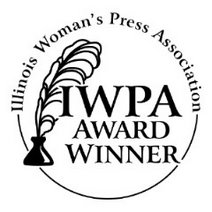
I've often admired people who could trace their families back to the "old country," wherever that country was. I always said that I couldn't trace mine because of my mixed heritage (English, French, German) and the relatively early times all of my ancestors entered the United States. None of the relatives I knew spoke of any ties to any "old country," or if they did, I ignored them. I just wasn't interested.
Recently, on the occasion of cleaning out my messy home office for new carpet installation, I discovered a yellowed document entitled "Historical Sketch and Genealogy of the John Adam Haag Family," prepared by H. Arthur Haag and dated October, 1949. In 1949, I was a high school senior, and probably not very interested in my roots. I didn't recognize the name Haag or bother to find out what this document was about. I apparently just put it into the miscellaneous collection of things I moved around with me, even on my last move from my house. I thought I'd done a good job of "decluttering" then, but you'd be surprised at how much remains. This time, curiosity prevailed, and I decided to read about the Haag family. What I discovered was, indeed, interesting, now that I'm old enough to appreciate it.
John Adam Haag was born in Wildenthierback, Oberamt Gerabron, Kingdom of Wurttemberg, Germany, on September 29, 1819. He lived there until 1845, when, "unwilling to continue longer enduring oppression and tyranny" at home, he and a cousin emigrated to the growing village of Milwaukee, Wisconsin, to find freedom. He worked as a cabinet maker and studied English at night. Later John was joined by his parents and other family members, and the entire family soon moved forty miles west to Helenville in what is now Jefferson County. There was not even a road to Helenville, but the entire family walked on a blazed trail through a dense forest, a two-day journey. They assembled a fairly large portion of farm land near Helenville.
John Adam soon married Barbarn Gunz, and all of the Haag relatives built log cabins on their properties. They hunted squirrels and prairie chickens, raised vegetables, collected sap and made maple sugar and syrup. They raised grain and grew fruit trees. John Adam also made wagon tongues from the white ash trees on his farm and hauled them forty miles west to Madison to sell. As a cabinet maker, he was called upon to make caskets for the pioneer community, priced at $10.00 each. John and his sons cut cordwood to haul to Whitewater (my old home town) by sled and sell. Oxen were used as draft animals, horses being scarce there until the 1860's.
Barbara Gunz Haag died in childbirth in 1856, and a about a year later, John married Anna Margaretha Haag (not related). By 1868, the Haags had eleven children, and John Adam needed more room so that his grown sons could live nearby. The land around Helenville was all taken, and the liquor was flowing a bit too freely. John Adam Haag was not a teetotaler, but the staunch Lutheran worried about the moral climate. The whole family set out for the new frontier across the Mississippi, the fertile black prairie land of northeastern Iowa. They settled in Sumner, Iowa, where John Adam continued his farming activities and managed a cane mill, then very important for processing the sorghum or cane used to manufacture the molasses often used on bread and pancakes. He died at age eighty-eight in 1907.
The John Adam Haag clan featured large families and long-lived descendants. Here is where I come in: My great-grandmother was John's daughter, Maria Margaretha Haag Hoffman (1847-1930). My paternal grandmother was Maria's daughter, Rosetta Hoffman Marshall (1881-1957). My father was Rosetta's son, Clifford William Marshall (1905-1974). Maria Margaretha and her husband George Hoffman did not make the move to Sumner, Iowa, with her parents, so my family tree continued to grow in Wisconsin, never far from the old Haag homestead in Helenville.
Since I was born in 1932, I never knew the first or second generations traced by H. (Hugo) Arthur Haag in 1949, The author (b. 1883) was a nephew of my great-grandmother, the son of one of her older brothers, George Jacob Haag (1851-1936), so he was a cousin of my Grandmother, Rosetta Hoffman Marshall. I never knew H. Arthur Haag, and I'm sure he's deceased by now. However, I salute him for his efforts to trace this very large family, and I'm sorry I didn't know him when I was young.
Genealogy is an interesting science. Most of us hope to find famous people, royalty, heroes, or captains of industry in our backgrounds, and I've always thought that my English and French ancestors, little though I know about them, were more lively, talented, interesting people than the "stodgy" Germans. But to quote H. Arthur Haag, John Adam was "honest, sober, industrious and God-fearing . . . loved by his family and respected by his neighbors, " with the qualities of courage, leadership and initiative. "The Haags are plain, simple, honest people, not uppish or pretentious; well enough off in a material sense to be capable of taking care of themselves without following mean occupations, and poor enough to show that they are not grabbing everything in sight." Thanks, H. Arthur. Those are good qualities I'm happy to share.
Copyright 2006 by Marlys Marshall Styne
Recently, on the occasion of cleaning out my messy home office for new carpet installation, I discovered a yellowed document entitled "Historical Sketch and Genealogy of the John Adam Haag Family," prepared by H. Arthur Haag and dated October, 1949. In 1949, I was a high school senior, and probably not very interested in my roots. I didn't recognize the name Haag or bother to find out what this document was about. I apparently just put it into the miscellaneous collection of things I moved around with me, even on my last move from my house. I thought I'd done a good job of "decluttering" then, but you'd be surprised at how much remains. This time, curiosity prevailed, and I decided to read about the Haag family. What I discovered was, indeed, interesting, now that I'm old enough to appreciate it.
John Adam Haag was born in Wildenthierback, Oberamt Gerabron, Kingdom of Wurttemberg, Germany, on September 29, 1819. He lived there until 1845, when, "unwilling to continue longer enduring oppression and tyranny" at home, he and a cousin emigrated to the growing village of Milwaukee, Wisconsin, to find freedom. He worked as a cabinet maker and studied English at night. Later John was joined by his parents and other family members, and the entire family soon moved forty miles west to Helenville in what is now Jefferson County. There was not even a road to Helenville, but the entire family walked on a blazed trail through a dense forest, a two-day journey. They assembled a fairly large portion of farm land near Helenville.
John Adam soon married Barbarn Gunz, and all of the Haag relatives built log cabins on their properties. They hunted squirrels and prairie chickens, raised vegetables, collected sap and made maple sugar and syrup. They raised grain and grew fruit trees. John Adam also made wagon tongues from the white ash trees on his farm and hauled them forty miles west to Madison to sell. As a cabinet maker, he was called upon to make caskets for the pioneer community, priced at $10.00 each. John and his sons cut cordwood to haul to Whitewater (my old home town) by sled and sell. Oxen were used as draft animals, horses being scarce there until the 1860's.
Barbara Gunz Haag died in childbirth in 1856, and a about a year later, John married Anna Margaretha Haag (not related). By 1868, the Haags had eleven children, and John Adam needed more room so that his grown sons could live nearby. The land around Helenville was all taken, and the liquor was flowing a bit too freely. John Adam Haag was not a teetotaler, but the staunch Lutheran worried about the moral climate. The whole family set out for the new frontier across the Mississippi, the fertile black prairie land of northeastern Iowa. They settled in Sumner, Iowa, where John Adam continued his farming activities and managed a cane mill, then very important for processing the sorghum or cane used to manufacture the molasses often used on bread and pancakes. He died at age eighty-eight in 1907.
The John Adam Haag clan featured large families and long-lived descendants. Here is where I come in: My great-grandmother was John's daughter, Maria Margaretha Haag Hoffman (1847-1930). My paternal grandmother was Maria's daughter, Rosetta Hoffman Marshall (1881-1957). My father was Rosetta's son, Clifford William Marshall (1905-1974). Maria Margaretha and her husband George Hoffman did not make the move to Sumner, Iowa, with her parents, so my family tree continued to grow in Wisconsin, never far from the old Haag homestead in Helenville.
Since I was born in 1932, I never knew the first or second generations traced by H. (Hugo) Arthur Haag in 1949, The author (b. 1883) was a nephew of my great-grandmother, the son of one of her older brothers, George Jacob Haag (1851-1936), so he was a cousin of my Grandmother, Rosetta Hoffman Marshall. I never knew H. Arthur Haag, and I'm sure he's deceased by now. However, I salute him for his efforts to trace this very large family, and I'm sorry I didn't know him when I was young.
Genealogy is an interesting science. Most of us hope to find famous people, royalty, heroes, or captains of industry in our backgrounds, and I've always thought that my English and French ancestors, little though I know about them, were more lively, talented, interesting people than the "stodgy" Germans. But to quote H. Arthur Haag, John Adam was "honest, sober, industrious and God-fearing . . . loved by his family and respected by his neighbors, " with the qualities of courage, leadership and initiative. "The Haags are plain, simple, honest people, not uppish or pretentious; well enough off in a material sense to be capable of taking care of themselves without following mean occupations, and poor enough to show that they are not grabbing everything in sight." Thanks, H. Arthur. Those are good qualities I'm happy to share.
Copyright 2006 by Marlys Marshall Styne


















No comments:
Post a Comment